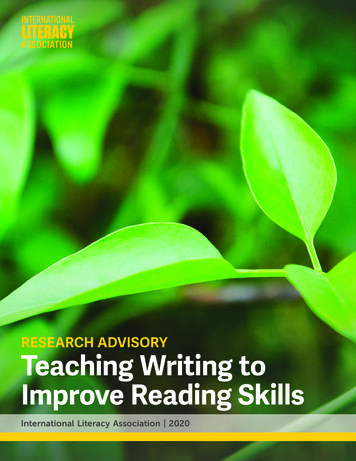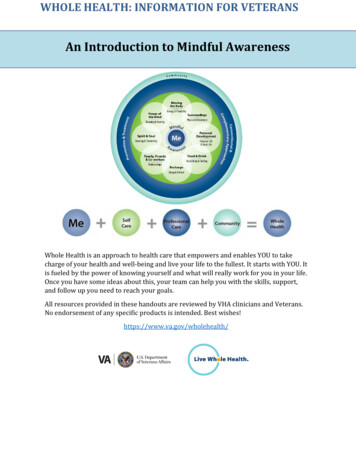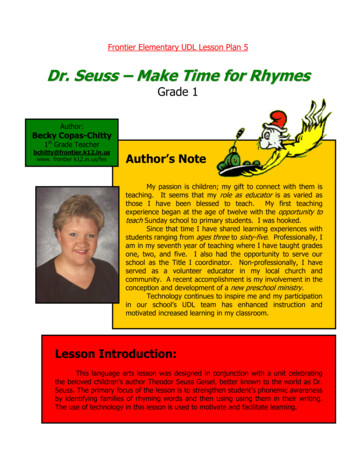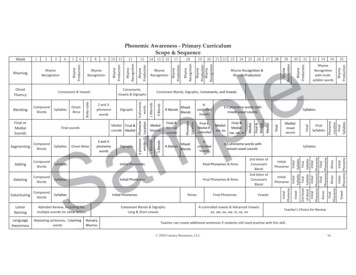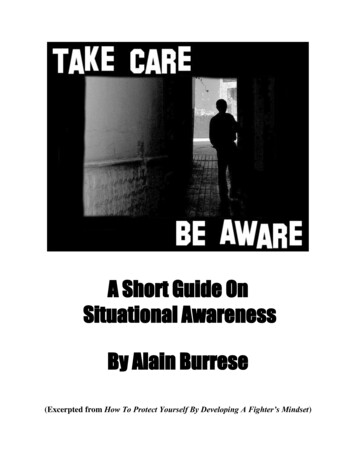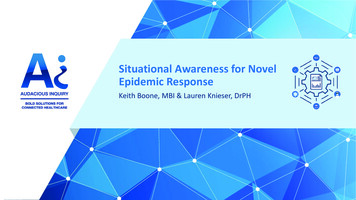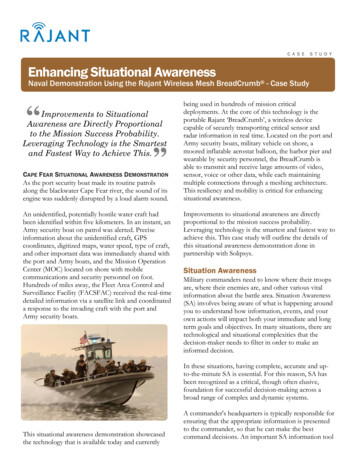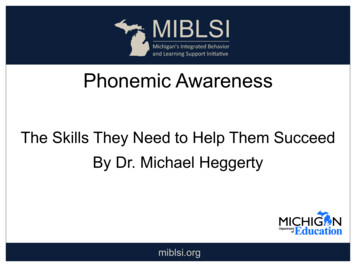
Transcription
Phonemic AwarenessThe Skills They Need to Help Them SucceedBy Dr. Michael Heggertymiblsi.org
Acknowledgments Dr. Michael Heggerty Dr. Anita Archer David Kilpatrick Dr. Roland Good Dr. Ruth Kaminski2
Group ExpectationsBe responsible Attend to the “Come back together” signal Active participation Please ask questionsBe Respectful Please allow others to listen Please turn off cell phone and pagersPlease limit sidebar conversations Share “air time” Please refrain from email and Internet browsingBe Safe Take care of your own needs3
Pause for Partnering4
Purpose and Intended OutcomesParticipants will: Define phonological & phonemic awareness Understand how phonemic awareness fits intothe science of teaching reading Know what to look for in phonemic awarenessdata to determine student needs Learn how to teach the lessons & practicedelivering the lessons5
Agenda1.0 The What: Phonological & Phonemic Awareness2.0 The Why: The Science of Teaching Reading3.0 The How: Get Ready to Teach4.0 The Who: Linking Program to Data6
1.0 The What: Phonological &Phonemic AwarenessBig Units to Small Units 7
In Module 1.0, We Will Define phonological & phonemic awareness Practice identifying the skills & tasksassociated with both Review the scope & sequence of the Heggertyprogram8
Phonological Awareness ReminderIts all about SPOKENsounds!No PRINT involved!9
Phonological Awareness: WhatA stair step image that captures three levels of tasks thatstudents can engage in at the word, syllable, onset-rime,and phoneme level. In the first stair step - the skills atthe beginning level are isolation, identification, andcategorization. The second stair step upward at themiddle level is blending and segmenting. The final stairstep is deletion, addition, and substitution.10
Activity 1.1Match Up!Use the cards provided. Read the activitydescription & place cards in order of level and task.11
Phonemic Awareness DevelopmentDepiction of when certain key phonemic awareness skills should be mastered. Blend and Segment are shownunder all of K up to the middle of 1st grade. Then from the middle of 1st grade up through 5th grade the skillsshift to phoneme analysis (addition, deletion, and substitution)There are three boxes that have the three levels of phonemic awareness development. The first one hasa label of Pre-K to Beginning K to signify that early phonological awareness is developed during this time.This consists of word, syllable, and onset-rime which are listed in the first box. The second box is labeledK to Mid 1st to signify the Basic Phonemic Awareness level, which consists of phoneme blending andsegmenting. The third box is labeled Mid 1st and On to signify Advanced Phonemic Awareness whichconsists of phoneme addition, deletion, and substitution.12
The Three Phases of Word Reading Developmentdepend on their Phonological CounterpartsPhonological SkillDevelopmentWord Reading DevelopmentEarly Phonological AwarenessLetters and SoundsBasic Phonemic AwarenessPhonic DecodingAdvanced PhonemicAwarenessAutomatic Word Decoding(Rhyme, Alliteration, Syllables, First SoundAwareness)(Phoneme Blending and Segmenting)(Phoneme Manipulation, Substitution, Deletion, Addition)Ehri, 2005; Kilpatrick, 201513
Phonemes: The DefinitionA phoneme is the smallest meaningful unit ofsound in spoken language.Phonemes are linguistic units, not units ofwriting.bitbaitbutteReith and Stuart, 2008bought14
Sounds in EnglishAlthough English has only 26 letters, it has:18 vowel phonemes 25 consonant phonemes43 distinct sounds15
Phoneme PracticeWord# of PhonemesWrite each phonemepen3/p/ /ĕ/ /n/cliffspeechknifemarker16
Phoneme Practice Answer KeyWord# of Phonemes Write each phonemepen3/p/ /ĕ/ /n/cliff4/c/ /l/ /ĭ/ /f/speech4/s/ /p/ /ee/ /ch/knife3/n/ /ie/ /f/marker4/m/ /ar/ /k/ /er/17
What is phonemic awareness?“Phonemic awareness refers to the ability tofocus on and manipulate phonemes in spokenwords.”National Reading Panel, 200018
Phonemic Awareness vs. PhonicsPhonemic AwarenessFocuses on phonemes(sounds)Deals with spoken languageAuditoryStudents work withmanipulating sounds andsounds in wordsHear the languagePhonicsFocuses on phoneme (sound)/grapheme (letter(s)associations)Deals with written languageVisual & AuditoryStudents work with reading &spelling words using phoneme/grapheme associationsSee text representing thelanguage19
Heggerty: Three Versions Primary (1st) – Yellow Kindergarten – Blue PreK - Purple20
About the Program – More What A research-based program for PreK, K, & 1st Intended to be done as a whole class Takes 12-15 minutes daily 35 weeks of curriculum provided Scope & Sequence designed to addressmultiple skill sets at increasing levels ofdifficulty (larger units to individual phonemes)21
Activity 1.2Scope & Sequence Kindergarten: Turn to page xv. 1st grade: Turn to page xiii. With your partner, review the weekly lessonskills/levels & the how the skills/levels ofdifficulty progress over 35 weeks. Answer thefollowing questions below: What stays consistent for 35 weeks? What changes over time & when do these changeshappen?22
Phonological Awareness Progression KTaskCompound Word SyllableWeek 1-4Week 5-8Onset-Rime PhonemeWeek 9-12Week 13 Blendafter noonnight timecan dydoc torc-abb-ack/b/ /a/ /t//h/ /i/ anAddroom bathroom classfunny ereasy erat /b/at /s/it /f/an -ingham - /h/fit - /f/rim - /r/doll – /d/Substitutebirthday – birth to colder – coldsun & the word is? to fast & theword is?bag - /b/ to/r/ & theword is?tock - /t/ to /r/& the wordis?23
What’s the Difference?Onset-RimeBody-Coda The onset is The boy of the wordeverything before theinvolves everything upvowel sound. Theto and including therime is the vowel andvowel. The coda iseverything after it ineverything that comesthe word.after the vowel sound.h-oophoo-pc-anca-n24
2.0 The Why: The Science of TeachingReadingLaw, Science, & Research Oh My!25
In Module 2.0, We Will: Review key elements of the Third GradeReading Law Clarify how phonemic awareness fits into thescience of teaching reading Understand what research says about teachingphonemic awareness Develop language to support the sense ofurgency around this critical skill26
Third Grade Reading LawRecent legislation emphasizes the following related to readinginstruction in order to ensure that all third graders are reading onor above grade level: Early screening assessment in reading for K-3 Evidence-based core reading instruction Individualized intervention for struggling K-3 readers Focus of the 5 major components of reading: PhonemicAwareness, Phonics, Fluency, Vocabulary &Comprehension Explicit & systematic instructionMichigan Department of Education27
Michigan Literacy EssentialsBy the Early Literacy Task Force, a subcommittee of theMichigan Association of Intermediate School Administrators(MAISA) General Education Leadership Network (GELN), whichrepresents Michigan’s 56 Intermediate School Districts28
Simple View of ReadingA formula introduced by Gough & Tunmer in 1986This graphis shows The Simple View of Reading.There are three important findings from the research behind the simple view of reading.1.Reading comprehension results from skills and knowledge that can be broken into two distinct and identifiable categories: decoding and language comprehension.*Decoding is defined as: efficient word recognition – this goes beyond the traditional def. of decoding as the ability to sound out words based on phonics rules. It includesfast/accurate reading of familiar and unfamiliar words in both lists and connected texts.*Language Comp is defined as: the ability to derive meaning from spoken words when they are part of sentences or other discourse. They encompass receptive vocabulary,grammatical understanding, and discourse comprehension.2.All reading difficulties fall into one of three general types: poor at language comprehension, poor at decoding, or both.3.Both decoding and language comprehension abilities are necessary for reading and both must be strong. Strength in one area cannot compensate for a deficit in the otherarea.Decoding X Language comprehesnion Reading ComprehensionWord-level reading and oral languagecomprehension are relatively independentabilities.Gough, 198629
Simple View of Reading: DecodingThis image shows the decoding skills represented by the right side of the Simple View ofReading equation. The progress of skills includes print concepts, phonological awareness,phonics and word recognition, word knowledge, and fluency. Print concepts is defined as theunderstanding of the organization and basic features of print. Phonological awareness isdefined as demonstrating the understanding of spoken words, syllables and sounds(phonemes). Phonics and word recognition is defined as the ability to know and apply gradelevel phonics and word analysis skill in decoding words. Word Knowledge or Sight Vocabularyis defined as instant and effortless access to all, or almost all, words read. Fluency is defined asreading with sufficient accuracy and rate to support comprehension. This graphic isrepresented as a stair step to show how each skill builds on the next.Gough, 1986: Kilpatrick, 201530
Simple View of Reading: SkillsAcademic BackgroundVocabulary KnowledgeAbility toAbility todiscuss topics clearly relate abeyond theseries ofimmediateeventscontextGough, 198631Ability tocomprehendand usewordsPossessesgeneral andtopic-specificbackgroundknowledge
Do Students Own This Skill?This image consists of threecolored circular linking arrowsgoing vertically down. The firstarrow is red and has the wordAcquisition under it and theword Learn outside of it. Thesecond arrow is yellow and hasthe word Accuracy under it andthe word Practice outside of it.The third arrow is green andhas the word Automaticityunder it and the word Ownoutside of it.32
Changing Emphasis of Big IdeasDepicts what big idea of reading fits with each gradelevel and what skills should be emphasized at eachgrade level. Across the top are columns that hasgrade K-5. Down the left hand side - the big ideas ofreading are listed. K-mid 1st grade key emphasis skillfor phonemic awareness is Blend and Segment. K-3'skey emphasis for Phonics is sounds/basic phonicsand advanced phonics & multisyllabic. Mid 1stthrough 3rd grade's emphasis for fluency is words andconnected text. 4th and 5th grade's emphasis shouldbe reading.33
Impact of Phonological Awareness“The degree of outcome in reading progressappears to be directly related to the presenceand nature of phonemic awareness training.”Degree of PAInstructionOutcomeStandard ScoreGainsNo PAMinimal0 to 5Basic PAModerate6 to 9Advanced PAStrong12.5 to 25Kilpatrick, 2015; p. 30334
Phonemic Awareness: Why“Every point in a child’s development of wordlevel reading is substantially affected byphonological awareness skills, from learningletter names all the way up to efficiently addingnew, multisyllabic words to their automaticword vocabulary.”Kilpatrick, 201535
Activity 2.1What Does Phonological Awareness Do Work with your partner and use the chartprovided to fill in how phonologicalawareness supports later literacydevelopment.36
What Phonological Awareness Does 1The ability to Will eventually help childrento Separate words intosyllables or beatsBreak down a word into parts tospell or decode/read it -- forexample, to spell popsicle, it is /pop//sic/ /l/Recognize and generatewords that rhymeUse known words to read newwords -- for example, to use scratchto help them read batchRecognize and generatewords that start or end withthe same soundLearn to associate particular soundswith particular letters -- for example,knowing that Peter starts with p mayhelp Peter recognize that purplealso starts with pAdapted from Bennett-Armistead, Duke & Moses, 2005)37
What Phonological Awareness Does 2The ability to Will eventually help childrento Separate words intosyllables or beatsBreak down a word into parts to spellor decode/read it -- for example, tospell popsicle, it is /pop/ /sic/ /l/Recognize and generatewords that rhymeUse known words to read new words-- for example, to use scratch to helpthem read batchRecognize and generatewords that start or end withthe same soundLearn to associate particular soundswith particular letters -- for example,knowing that Peter starts with p mayhelp Peter recognize that purple alsostarts with pAdapted from Bennett-Armistead, Duke & Moses, 2005)38
What Phonological Awareness Does 3The ability to Will eventually help childrento Separate words intosyllables or beatsBreak down a word into parts to spellor decode/read it -- for example, tospell popsicle, it is /pop/ /sic/ /l/Recognize and generatewords that rhymeUse known words to read new words-- for example, to use scratch to helpthem read batchRecognize and generatewords that start or end withthe same soundLearn to associate particular soundswith particular letters -- for example,knowing that Peter starts with p mayhelp Peter recognize that purple alsostarts with pAdapted from Bennett-Armistead, Duke & Moses, 2005)39
Phonemic Awareness & Spelling Link Students must be aware of phonemes withinwords in order to map graphemes ontophonemes. (Ehri & Roberts, 2006) Phonemic awareness is central in learning toread and spell. (Ehri, 1984)40
Activity 2.2 Research FindingsPartner #1 read page i.Partner #2 read page ii.Select 1-2 findings to share with your partner from yourassigned page.With your partner, use the slides in Module 3.0 to agree ordisagree with the statement below. Phonemic awareness instruction is an essential part ofliteracy programs from Pr-eK through 5th grade.What parts of this module might your grade level team orleadership team need to know regarding this skill?41
The Why: Take Home Points Phonemic awareness instruction is an essential part ofliteracy programs from PreK through 5th grade. AGREE! Blending & Segmenting are great first steps to creatingreaders and writers. We blend to read.We segment to spell.However, Phoneme Analysis (Addition, Deletion, &Substitution) will build automaticity & strengthen the rate atwhich students store & retrieve information.42
3.0 The How: Get Ready to TeachInsert drumroll, here.43
In Module 3.0, We Will Understand continuous & stop sound Be able to make then accurately Understand voiced & unvoiced sounds & whythat matters Review the key elements of explicit instruction Learn & practice the lessons in Heggerty44
Consistent Sound Messages Instruction in sounds includes: Stop vs. continuous sounds Voiced vs. unvoiced Pronunciation (how to accurately say the sounds)45
Continuous & Stop Sounds Defined Continuous sounds: sounds can bemade until a person runs out ofbreath without distorting the sound Examples: /s/, /m/, /a/ Stop sounds: sounds produced withone short push of breath If a stop sound is held, the sound will bedistorted Examples: /b/, /g/, /t/46
Continuous vs. Stop /m//n//r//s//v//w//y//z/All vowel sounds (name andsound)47
Voiced vs. Unvoiced Sounds Voiced sounds: spoken with the “voice box”turned on or resonating Unvoiced sounds: spoken with the “voice box”turned off, like a whisper48
Sound Pronunciation GuidanceAn image of thesoundpronunciationguide thatshowsparticipants howto accuratelymake thesounds. It hasexample wordsfor each soundas well as adescriptor tohelp pronouncethe sound.There are voweland consonantphonemeslisted. Forexample, thesound F islabeled as anunvoicedfricativecontinuous withfog listed as anexample.49
Activity 3.1Let’s PracticeAs we watch the video of the correct pronunciationof sounds, make each sound after thedemonstrator50
Phoneme/Grapheme Practice51
Activity 3.2Sound Practice Locate the Sound Pronunciation Sheet in the back of yourworkbook Partner 1 practice making the voiced/unvoiced andcontinuous/stop sounds. Partner 2 provide feedback. Switch and continue until time runs out 52
How are the skills taught? From easy exercises to more difficult From larger units (e.g., compound words, tosyllables) to smaller units (phonemes) From highly supported activity (T: says wordand first sound; S: read word and first sound)to independent activity (T: says word; S: repeatthe word and the first sound)53
Activity 3.3Scope & Sequence PracticeSee what you can recall about the program setup. (If you need ahint, refer to pages xv or xiii.)1. Naming2. Rhyming3. (Beginning Sounds)4. Blending5. Final & Phonemes6. Segmenting7. Phonemes8. Adding Phonemes9. Phonemes10. Language54
Check Your Work1. Letter Naming2. Rhyming3. Onsets (First Sounds)4. Blending5. Final & Medial Phonemes6. Segmenting7. Substituting Phonemes8. Adding Phonemes9. Deleting Phonemes10.Increasing language skills55
How ExplicitNew activities should be introduced usingexplicit instruction:I do it.We do it.You do it.56
Expert Minute: Explicit Instruction57
How: Active EngagementRequest for Frequent Responses: Choral Responses Hand Signals Gestures / Actions58
How: Brisk PaceMaintain a brisk pace: Preview the lesson Establish & use routines Use clear, concise teacher language Limit digressions Stay focused59
How: Provide CorrectionsWhen a student or students make an error, saythe correct response & have students repeat thecorrect response.Think:1. Tell2. Ask3. Start again60
A Training Example61
K Rhyming Lesson ComponentsKindergarten Hearing and Repeating words that rhyme (kindergarten p. 1) Rhyme Recognition: Which word rhymes with? (kindergartenp. 25)62
K and Primary Rhyming Lesson ComponentsKindergarten and Primary- Recognizing rhyming words (primary p. 1, kindergarten p. 1)- Recognizing rhyming words in a series (primary p. 19,kindergarten p. 7)- Producing a rhyming word with a rime or familiar word (primaryp. 28, kindergarten p. 34)- Producing a rhyming word with a nonsense word (primary p.13, kindergarten p. 19)63
Rhyming – K Teacher PerspectiveSkills: RhymingWednesday Teacher says the category.Teacher says the nonsenseword.Category: Parts of your Bodyleyeballs(eyeballs) Students repeat thenonsense word and say, Not(nonsense word), (real word)zed(head)deet(feet)mingers(fingers) Ex: T: The number is zine.pands(hands)S: Not zine, nine!barms(arms)kips(lips)(K, Wk 7 p. 19)64
Rhyming – Primary Teacher PerspectiveSkills: RhymingWednesday(Primary, Wk 7 p. 19) Instructions vary by dayhad, bid, hiddid, bad, dadran, run, bunton, den, menbag, beg, eggcap, cup, pupgum, hem, gemhat, hot, lotsap, sip, hip Mon, Wed, & Fri: Teacherreads the word set. Studentsrepeat only the two rhymingwords. Tues & Thurs: Teacher says theword pair. Students repeat theword pair and show thumbs up ifthe words rhyme, thumbs down ifthey don’t rhyme65
Producing Rhyme Classroom Example66
Rhyming Classroom Example67
Activity 3.4Rhyming Practice1. Acquisition: Experience this lessoncomponent as a student first.2. Accuracy: Work with your partner to developyour instructional delivery of this section.3. Automaticity: Put it into practice with yourassigned group –stand and deliver practice.4. Do You Own This Skill?68
Onset Lesson ComponentsKindergarten: Isolating onset phonemes (initial sounds) inspoken words (p. 1) Phoneme Categorization: Which word beginslike *? (p. 19) Identifying same onset phonemes in a series ofwords or sentence (p. 13)69
Primary: Onset Lesson ComponentsPrimary: Isolating onset phonemes (initial sounds) inspoken words (p. 1) Isolating the onset phoneme in a series ofwords (p. 7) Phoneme Categorization (p. 37)70
Onsets – K Teacher PerspectiveSkill: OnsetWednesday(K, WK 7, p. 19) Teacher says, “Which wordbegins like *?” and says thetwo words.Which word begins like *?jacket:wing:kind:read:vine: Students say the work thathas the same onset. EX: T: Which word beginslike can; cake or mop?S: cake71pond, jeeplive, windowkite, touchmust, ropevase, neck
Onsets – Primary Teacher PerspectiveSkills: OnsetWednesday(Primary, Wk 7 p.19) Teacher says the word. Students repeat the word andisolate the onset. If the onset is a vowel, studentsidentify it as a short or longvowel sound. Students say sound, not lettername.72episodevolunteergarageitchygigantic/e / */v//g//i /*/j/
Onset Classroom Example73
Activity 3.5Onset Practice1. Acquisition: Experience this lessoncomponent as a student first.2. Accuracy: Work with your partner to developyour instructional delivery of this section.3. Automaticity: Put it into practice with yourassigned group –stand and deliver practice.4. Do You Own This Skill?74
Blending Lesson Components Blending individual words into compoundwords (k and primary p. 1) Blending syllables into spoken words(k, p. 13: primary p. 7) Blending onset with rime/body-coda intospoken words (k, p. 25/31: primary 13/19) Blending Phonemes with Elkonin Boxes(k, p. 37) Blending phonemes into spoken words(k, 40: primary, p. 22)75
Reminders: Phonological AwarenessA stair step image that captures three levels of tasks thatstudents can engage in at the word, syllable, onset-rime,and phoneme level. In the first stair step - the skills atthe beginning level are isolation, identification, andcategorization. The second stair step upward at themiddle level is blending and segmenting. The final stairstep is deletion, addition, and substitution.76
Blending Hand Motions77
Blending – K Teacher PerspectiveSkills:BlendingWednesday(K, Wk 7,p.19 ) Teacher says the syllables. Students repeat the syllablesand blend them together tosay the whole word. Students count the number ofsyllables in each word andsay the number aloud.ex: T: use - fulS: use - ful, useful, larcra-dlediff-er-entlo-tioncam-pusbanana(3)spoken (2)habitat (3)explain (2)squirted (2)popular (3)cradle (2)different (3)lotion (2)campus (2)
Blending Classroom Example79
Blending – Primary Teacher PerspectiveSkills:BlendingWednesday(Primary, Wk 7,p.19 )Focus on final sounds Teacher says the beginningof the word and the isolatedending sound. Students say the whole word.ex. T: lif - tS: lift80lum-phun - tsif - tcam - psen - dban - dtil - tjum - pten - tlumphuntsiftcampsendbandtiltjumptent
Activity 3.6Blending Practice1. Acquisition: Experience this lessoncomponent as a student first.2. Accuracy: Work with your partner to developyour instructional delivery of this section.3. Automaticity: Put it into practice with yourassigned group –stand and deliver practice.4. Do You Own This Skill?81
K: Isolating Final or Medial PhonemeLesson ComponentsKindergarten: Isolating final phonemes in spoken words p. 1 Identifying same final phonemes in a series ofspoken words p. 13 Isolating medial phonemes in spoken words p. 37 Phoneme Location: Identifying a blend/diagraphas the initial, medial or final sound p. 8582
Primary: Isolating Final or Medial PhonemeLesson ComponentsPrimary: Isolating final phonemes in spoken words (p. 1) Isolating medial phonemes in spoken words (p.28) Phoneme Categorization (p. 25) Isolating final syllables in spoken words (p. 94) Phoneme Location (p. 37)83
Isolating Final Phonemes Hand Motions84
Isolating Medial Phonemes Hand Motions85
Final & Medial – K Teacher PerspectiveSkills: BlendingWednesday(Primary, Wk7,p.19 ) Teacher says wordsiphamrackbigmanlickgap Students repeat the wordusing the roller coaster handmotion, and isolate themedial soundex. T: batS: bat, /a/86/i//a//a//i//a//i//a/
Medial Sound Classroom Example87
Final & Medial – Primary Teacher PerspectiveSkills: Final and MedialWednesday(Primary, Wk7,p.19 ) Teacher read each sentence Students isolate the repeatedfinal soundex. T: Dad tried hardS: /d/88Will Jill still fall?Big frog dug.Pat got wet.Don won ten.Jay may play.Dad called Ted.Liz rides cows./l//g//t//n//a//d//z/
Activity 3.7Final and Medial Phonemes Practice1. Acquisition: Experience this lessoncomponent as a student first.2. Accuracy: Work with your partner to developyour instructional delivery of this section.3. Automaticity: Put it into practice with yourassigned group –stand and deliver practice.4. Do You Own This Skill?89
Segmenting Lesson Components Segmenting individual words in compoundwords (k, p. 2, primary p. 2) Segmenting syllables in spoken words(k, p. 14; primary, p. 8) Segmenting onset and rime in spoken words(k, p. 26; primary, p. 14) Segmenting phonemes in spoken words(k, p. 38; primary, p. 23)90
Reminder: Where does Segmenting Fit?A stair step image that captures three levels of tasks thatstudents can engage in at the word, syllable, onset-rime,and phoneme level. In the first stair step - the skills atthe beginning level are isolation, identification, andcategorization. The second stair step upward at themiddle level is blending and segmenting. The final stairstep is deletion, addition, and substitution.91
Segmenting Hand Motions92
Segmenting – K Teacher PerspectiveSkill: SegmentingWednesday(K, Wk7,p.20 )flexible Teacher says the whole word biggest Students repeat the word & successfulsegment it into syllables, and glittertrampolinecount syllables.handlerecommendFridayex. T: fantasticS: fantastic, fan-tas-tic, 3 erwhis-per-ing(3)(2)(3)(2)(3)(2)(3)(2)(3)(3)
Segmenting – Primary Teacher PerspectiveSkill: SegmentingWednesday(Primary, Wk7, p.19 ) Teacher says the whole word Students repeat the word &segment it into onset andrime.ex. T: lumpS: lump, l – ump*Students say sounds, not tlandb - ests - ingb - endl - astb - unchsh - ockn - extb - unkr - entl - and
Segmenting Classroom Example95
Activity 3.8Segmenting Practice1. Acquisition: Experience this lessoncomponent as a student first.2. Accuracy: Work with your partner to developyour instructional delivery of this section.3. Automaticity: Put it into practice with yourassigned group –stand and deliver practice.4. Do You Own This Skill?96
K: Adding Lesson ComponentsKindergarten: Adding words to make compound words (p. 2) Adding syllables to words or word parts (p. 14) Adding initial phonemes to spoken words (p.26) Adding final phonemes or syllables to spokenwords (p. 95)97
Primary Adding Lesson ComponentsPrimary Adding words to make compound words (p. 2) Adding syllables to words or word parts (p. 8) Adding initial phonemes to spoken words (p. 14) Adding final phonemes to spoken words (p. 56) Adding a rime to the end of a word (p. 59) Adding the second phoneme to make aconsonant blend (p. 74)98
Adding Hand Motions99
Adding Words – K Teacher PerspectiveSkill: SegmentingWednesday(K, W1, p. 2 ) Teacher says the word Students repeat the wordTeacher says add /*/ at thebeginning/end and the wordis?ex. T: snowS: snowT: Add /ball/ at the end andthe word is?S: snowballhead- /ache/ headachehead- /phones/ headphoneshead- /light/ headlighthead- /band/ headbandhead- /stand/ headstand100
Adding Words – Primary Teacher PerspectiveSkill: SegmentingWednesday(Primary, Wk7, p.20 ) Teacher says rime. Students repeat the rime.Teacher says add /*/ at thebeginning/end and the wordis?Ex. T: ampS: ampT: Add /r/ at the beginningand the word is?S: /r//m//w//j/Responsefixdicelakerockmuchwillgem
Adding Classroom Example102
Activity 3.9Adding Practice1. Acquisition: Experience this lessoncomponent as a student first.2. Accuracy: Work with your partner to developyour instructional delivery of this section.3. Automaticity: Put it into practice with yourassigned group –stand and deliver practice.4. Do You Own This Skill?103
Kindergarten Deleting Lesson ComponentsKindergarten Deleting words from compound words (p. 2 ) Deleting syllables from spoken words (p. 14 ) Deleting initial phonemes from spoken words(p. 26) Deleting final phonemes from spoken words(p. 95)104
Primary Deleting Lesson ComponentsPrimary Deleting words from compound words (p. 2 ) Deleting syllables from spoken words (p. 8 ) Deleting initial phonemes from spoken words (p. 14) Deleting final phonemes from spoken words (p. 56) Deleting the rime from the end of a spoken word(p. 59) Deleting the second phoneme from a consonantblend (p. 74)105
Deleting Hand Motions106
Deleting Words – K Teacher PerspectiveSkill: SegmentingWednesday(K, Wk1 p.2 ) Teacher says word. Studentsrepeat the word. Teachersays, “Without /*/ what’s leftis?Ex. T: anywayS: anywayT: Without /any/, what’sleft is?S: wayHand motions: Open palmsDelete from the sponsetimehousegroundthingroom
Deleting Words – Primary Teacher PerspectiveSkill: SegmentingWednesday(primary, Wk7 p.20 ) Teacher says the word.Students repeat the word .Teacher says, “Without /*/,what’s left is?Ex. T: helpS: helpT: Without /h/, what’s leftis?S: elpHand motions: Open palmsDelete from the mpokeenubeopeanite
Deleting Classroom Example109
Activity 3.10Deleting Practice1. Acquisition: Experience this lessoncomponent as a student first.2. Accuracy: Work with your partner to developyour instructional delivery of this section.3. Automaticity: Put it into practice with yourassigned group –stand and deliver practice.4. Do You Own This Skill?110
Kindergarten Substitutin
knife. 3 /n/ /ie/ /f/ marker: 4 /m/ /ar/ /k/ /er/ 18 . The progress of skills includes print concepts, phonological awareness, phonics and word recognition, word knowledge, and fluency. Print concepts is defined as the understanding of the organizati

